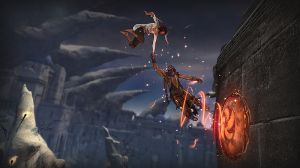Review
 Last generation’s Prince of Persia was like a hormonal teenager. Once a child prodigy, he became dark, angsty, and over-sexed. This year’s prince is different. He’s less angry and more snarky. He spouts endless one-liners. He’s the Persian equivalent of the surfer-bro, Abercrombie-wearing type. Prince of Persia begins with the unnamed protagonist lost and looking for his donkey Farah – an homage to the love interest in the 2003 Prince of Persia: Sands of Time. It unintentionally doubles as an homage to better times, as he’s quickly paired up with a new, albeit less interesting female sidekick, Elika. Together they travel a strange land, freeing it of corruption and evil.
Last generation’s Prince of Persia was like a hormonal teenager. Once a child prodigy, he became dark, angsty, and over-sexed. This year’s prince is different. He’s less angry and more snarky. He spouts endless one-liners. He’s the Persian equivalent of the surfer-bro, Abercrombie-wearing type. Prince of Persia begins with the unnamed protagonist lost and looking for his donkey Farah – an homage to the love interest in the 2003 Prince of Persia: Sands of Time. It unintentionally doubles as an homage to better times, as he’s quickly paired up with a new, albeit less interesting female sidekick, Elika. Together they travel a strange land, freeing it of corruption and evil.
The game takes inspiration from the Playstation 2 title, Ico, in which a boy protects a princess from monsters, holding her hand and building a silent bond throughout. Your sidekick in Prince of Persia, Elika, acts as a more capable version of the princess in that game. Rather than holding her hand throughout, constantly protecting her from harm, you’ll find Elika is actually the more capable one. While she follows you, she constantly saves you from falls – her magic acts as a quick checkpoint system. She’s also rather talkative, unlike Ico’s mute princess.

Developer Ubisoft clearly took the “tell” rather than “show” approach here, with Elika acting more as a vessel for endless exposition than a truly compelling character. Right from the start you’re inundated in mystical mumbo-jumbo. The evil god Arihman is nearly free of his shackles, he’s pissed, and he’s covering the land in inky blackness. Blessed with the powers of Ormazd, Elika must make her way to the fertile grounds, cleansing the area of corruption to return Arihman to his prison. Throughout the game they speak endlessly of these gods, great ancient cities, and stories of the past. It’s needlessly complex fantasy that will bore well before the game even picks up.
What the story does offer is an excuse to go from area to area, fighting monsters, cleansing the land, and collecting enough light seeds to access new areas. Plot devices explain the process, but it doesn’t make it any less repetitive. After seeing Elika perform the same cleansing ritual for the tenth time it was hard to deny some sexual innuendo there. Maybe it’s a side effect of delirium caused by a game that goes on for far too long, but there’s something suspicious about the sequence. Elika, the admitted virgin, approaches the fertile ground. At that point you jam on the Y (chromosome) button until she screams and light floods from her. At that point the world becomes a rainbow of color and a trail of “light seeds” is left behind. Yep.

Without an engaging plot or believable world, Prince of Persia still manages to entertain. The eye-candy is undeniable – the graphics evoke a fairytale storybook without being too stylized. The score is a sweeping mix of Hollywood Persia and Star Wars that never betrays the setting. In fact, aesthetically the game is perfect, firing on all cylinders and accomplishing all it has set out to do.
The adventure is a mix of platforming and light combat. Unlike something like Mirror’s Edge, where the player is allowed infinite nuance to perfect their moves, Prince of Persia is rather automatic. As the prince’s graceful animations play out it’s up to the player to observe the next obstacle and react, typically by pressing one of four buttons, with little timing involved. It’s a simplified system that allows for long stretches of aerial movements. Each piece of solid ground acts as a save point, breaking up longer stretches of wall-running, climbing, swinging, and magic as the game goes on. One false move means a last second save from Elika, a unique and in-universe way to revert the player to a previous checkpoint.

The combat follows this tune, remaining faithful to the simplified but graceful aspects of the prince’s acrobatics. The rules are the same, observe threats and react, with any mistakes resulting in a save from Elika. But what’s entertaining in the platforming is boring in combat. Each of the enemies must be fought five times before seeing their end, and once is already enough. The fights go on too long, feature far too many canned animations, and ultimately feel like more of a roadblock than a conflict.
The pros and cons of Prince of Persia are always present. Every gameplay mechanic is explained early on. The plot, difficulty, and presentation do little to surprise. Within thirty minutes you’ll have seen all that the game has to offer. Some will enjoy this, but most will find that the routine magnifies the flaws. Only in the very last hour does it seem to aspire to something. The prince finally shows his true colors, making a decision that is both unexpected and poetic, but asking the player to connect to these characters at that point is asking too much. It’s a noble effort to wrap up the game artfully, but even then it’s thrown away in favor of a cliffhanger ending sure to ensnare thousands of future customers.

[url=http://cialisnowdirect.com/#khxnf]cialis 10 mg[/url] – cialis 20 mg , http://cialisnowdirect.com/#olsel cheap cialis online
[url=http://paydayloansheredirectly.com/#oczfr]payday loans[/url] – direct lender payday loans , http://paydayloansheredirectly.com/#ckqli payday loans